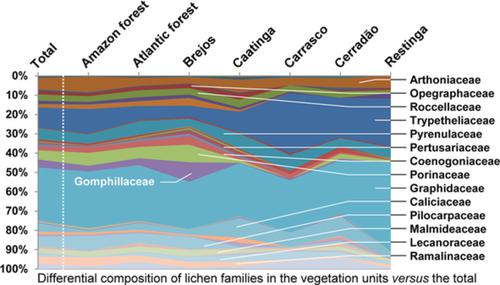当前位置:
X-MOL 学术
›
Ecol. Res.
›
论文详情
Our official English website, www.x-mol.net, welcomes your feedback! (Note: you will need to create a separate account there.)
Phylogenetic structure of lichen metacommunities in Amazonian and Northeast Brazil
Ecological Research ( IF 2 ) Pub Date : 2021-03-23 , DOI: 10.1111/1440-1703.12206 Edvaneide Leandro de Lima Nascimento 1 , Leonor Costa Maia 1 , Marcela Eugenia da Silva Cáceres 2 , Robert Lücking 3
Ecological Research ( IF 2 ) Pub Date : 2021-03-23 , DOI: 10.1111/1440-1703.12206 Edvaneide Leandro de Lima Nascimento 1 , Leonor Costa Maia 1 , Marcela Eugenia da Silva Cáceres 2 , Robert Lücking 3
Affiliation

|
Amazon, Atlantic forest, Brejos de Altitude, Caatinga, Carrasco, Cerradão and Restinga are major vegetation units in North and Northeast Brazil. Little is known about lichen metacommunity structure in these habitats. While species richness and composition generally depend on climatic factors, in azonal vegetation edaphic factors may have a filtering effect on tree bark structure and hence the composition of epiphytic lichen communities. We hypothesized that climatic stress and a tree bark filtering effect would result in reduced richness and phylogenetic clustering in Caatinga, Carrasco, Cerradão and Restinga, whereas high richness and phylogenetic overdispersion were predicted for Amazon and Atlantic Forest. To test this, we analyzed 2,090 lichenized species in the study area, with a supertree to assess phylogenetic metacommunity structure. Amazon and Atlantic forest exhibited high richness and phylogenetic diversity, with phylogenetic overdispersion only in the Amazon. The zonal Caatinga with drought stress and the extrazonal Brejos both exhibited phylogenetic clustering. Among the azonal, edaphic vegetation units, Cerradão exhibited phylogenetic overdispersion, whereas Restinga showed phylogenetic clustering. Nearest taxon phylogenetic distance indicated a close relationship between Amazon and Atlantic forest, Atlantic forest and Brejos and Atlantic forest and Caatinga. Carrasco was mostly closely related to Cerradão, and Restinga was distantly related to any other unit. These findings indicate more complex patterns in the phylogenetic structure of lichen metacommunities, partly reflecting those of plant metacommunities, as a result of concurrent macroecological evolutionary histories. Our data supported floristic evidence that Carrasco is part of the Cerrado complex and not related to Caatinga.
中文翻译:

巴西亚马逊和巴西东北部地衣群落的系统发生结构
亚马逊,大西洋森林,高空布雷霍斯,卡廷加,卡拉斯科,塞拉多和雷廷加是巴西北部和东北部的主要植被单元。对于这些栖息地中的地衣元群落结构了解甚少。尽管物种的丰富度和组成通常取决于气候因素,但在地带性植被中,edaphic因子可能对树皮结构以及附生地衣群落的组成具有过滤作用。我们假设气候压力和树皮过滤效果将导致Caatinga,Carrasco,Cerradão和Restinga的丰富度和系统发生聚类减少,而亚马逊和大西洋森林则具有较高的丰富度和系统发生过分分散。为了验证这一点,我们分析了研究区域内的2,090种地衣化物种,并以一棵超级树评估了系统发生的元群落结构。亚马逊和大西洋森林表现出很高的丰富度和系统发育多样性,仅在亚马逊地区系统发育过度分散。带干旱胁迫的带状Caatinga和带状Brejos均表现出系统发育聚类。在纬向,深层植被单元中,Cerradão表现出系统发育过度分散,而Restinga表现出系统发育聚类。最近的分类群系统发育距离表明亚马逊和大西洋森林,大西洋森林和布雷霍斯以及大西洋森林和卡廷加之间有密切的关系。卡拉斯科(Carrasco)与塞拉多(Cerradão)密切相关,而雷廷加(Restinga)与其他任何部门都息息相关。这些发现表明,地衣元社区的系统发育结构更为复杂,部分反映了植物元社区的系统发育,由于同时存在的宏观生态进化史。我们的数据支持了植物学证据,表明Carrasco是Cerrado建筑群的一部分,与Caatinga无关。
更新日期:2021-05-17
中文翻译:

巴西亚马逊和巴西东北部地衣群落的系统发生结构
亚马逊,大西洋森林,高空布雷霍斯,卡廷加,卡拉斯科,塞拉多和雷廷加是巴西北部和东北部的主要植被单元。对于这些栖息地中的地衣元群落结构了解甚少。尽管物种的丰富度和组成通常取决于气候因素,但在地带性植被中,edaphic因子可能对树皮结构以及附生地衣群落的组成具有过滤作用。我们假设气候压力和树皮过滤效果将导致Caatinga,Carrasco,Cerradão和Restinga的丰富度和系统发生聚类减少,而亚马逊和大西洋森林则具有较高的丰富度和系统发生过分分散。为了验证这一点,我们分析了研究区域内的2,090种地衣化物种,并以一棵超级树评估了系统发生的元群落结构。亚马逊和大西洋森林表现出很高的丰富度和系统发育多样性,仅在亚马逊地区系统发育过度分散。带干旱胁迫的带状Caatinga和带状Brejos均表现出系统发育聚类。在纬向,深层植被单元中,Cerradão表现出系统发育过度分散,而Restinga表现出系统发育聚类。最近的分类群系统发育距离表明亚马逊和大西洋森林,大西洋森林和布雷霍斯以及大西洋森林和卡廷加之间有密切的关系。卡拉斯科(Carrasco)与塞拉多(Cerradão)密切相关,而雷廷加(Restinga)与其他任何部门都息息相关。这些发现表明,地衣元社区的系统发育结构更为复杂,部分反映了植物元社区的系统发育,由于同时存在的宏观生态进化史。我们的数据支持了植物学证据,表明Carrasco是Cerrado建筑群的一部分,与Caatinga无关。


























 京公网安备 11010802027423号
京公网安备 11010802027423号